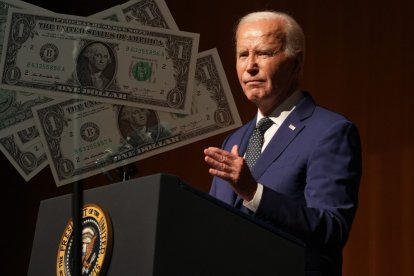Americans depend more than ever on government funding
"In 2022, Americans received $3.8 trillion in government transfer income. If that were divided equally among the entire U.S. population, it would be about $11,500 per person," noted a report by the Economic Innovation Group.

Joe Biden delivering a speech
A new report from the Economic Innovation Group (EIG) highlighted a major shift in the nation's economic and social landscape, noting that more than 53% of counties nationwide now rely on government support for at least a quarter of their total revenue. This figure represents a drastic increase from levels seen in 2000, when only one in 10 counties was in this situation.
In recent decades, one factor that has influenced this trend is the increasing reliance of citizens on government support programs, such as Social Security, Medicare and Medicaid. This network of government plans is now a significant source of income for many communities, primarily caused by the economic decline and due in part to the aging population.
Increasing dependence on government programs
Citizens' dependence on the government is on the rise for several reasons. The aging population is one of them, which has resulted in increased demand for programs such as Social Security and Medicare, designed to provide financial and medical support to the elderly. Today, over 17% of Americans are 65 or older, compared with only 10% in 1970. This population increase has also raised the cost of health care to unprecedented levels.
Added to this are the financial problems that have plagued all regions of the country. Government money has become an essential part of personal income, which is a doomsday scenario for any economy.
The political impact of aid
Regarding how politics influences spending, EIG's analysis shows that many of the counties most dependent on government support tend to vote Republican. This could mean that voters want their personal finances to improve so they are not dependent on the government, as the GOP has historically been known for reducing government spending and boosting entrepreneurship.
In the 2020 presidential election, Donald Trump won an overwhelming majority of counties that rely significantly on government money. In places like Cambria County, Pennsylvania, where 35% of revenue comes from the government, Trump won 68% of the vote. These counties, though small in terms of population, are crucial on the electoral map.
According to the analysis, nearly 70% of counties in key states like Michigan, Georgia and North Carolina rely on government programs for a substantial portion of their revenues. In Pennsylvania, that percentage stands at close to 60%.
Likewise, the report shows another trend: "In general, areas that are older, more rural, and less wealthy tend to be significantly reliant on transfers. In contrast, many metropolitan hubs, affluent suburbs and exurbs, and high-income, high-productivity farming and mining communities remain minimally reliant on transfer income to power their local economies."
RECOMMENDATION





















